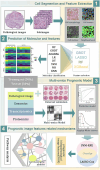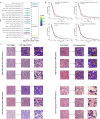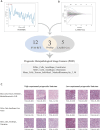Integration of histopathological image features and multi-dimensional omics data in predicting molecular features and survival in glioblastoma
- PMID: 40337276
- PMCID: PMC12055811
- DOI: 10.3389/fmed.2025.1510793
Integration of histopathological image features and multi-dimensional omics data in predicting molecular features and survival in glioblastoma
Abstract
Objectives: Glioblastoma (GBM) is a highly malignant brain tumor with complex molecular mechanisms. Histopathological images provide valuable morphological information of tumors. This study aims to evaluate the predictive potential of quantitative histopathological image features (HIF) for molecular characteristics and overall survival (OS) in GBM patients by integrating HIF with multi-omics data.
Methods: We included 439 GBM patients with eligible histopathological images and corresponding genetic data from The Cancer Genome Atlas (TCGA). A total of 550 image features were extracted from the histopathological images. Machine learning algorithms were employed to identify molecular characteristics, with random forest (RF) models demonstrating the best predictive performance. Predictive models for OS were constructed based on HIF using RF. Additionally, we enrolled tissue microarrays of 67 patients as an external validation set. The prognostic histopathological image features (PHIF) were identified using two machine learning algorithms, and prognosis-related gene modules were discovered through WGCNA.
Results: The RF-based OS prediction model achieved significant prognostic accuracy (5-year AUC = 0.829). Prognostic models were also developed using single-omics, the integration of HIF and single-omics (HIF + genomics, HIF + transcriptomics, HIF + proteomics), and all features (multi-omics). The multi-omics model achieved the best prediction performance (1-, 3- and 5-year AUCs of 0.820, 0.926 and 0.878, respectively).
Conclusion: Our study indicated a certain prognostic value of HIF, and the integrated multi-omics model may enhance the prognostic prediction of GBM, offering improved accuracy and robustness for clinical application.
Keywords: genomics; glioblastoma; histopathological image; prognosis; proteomics; transcriptomics.
Copyright © 2025 Huang, Chen, Zhang, Liu, Huang, Liu, Liu, Song, Li and Zhang.
Conflict of interest statement
The authors declare that the research was conducted in the absence of any commercial or financial relationships that could be construed as a potential conflict of interest.
Figures









Similar articles
-
Integration of histopathological images and multi-dimensional omics analyses predicts molecular features and prognosis in high-grade serous ovarian cancer.Gynecol Oncol. 2021 Oct;163(1):171-180. doi: 10.1016/j.ygyno.2021.07.015. Epub 2021 Jul 16. Gynecol Oncol. 2021. PMID: 34275655
-
Histopathological Images and Multi-Omics Integration Predict Molecular Characteristics and Survival in Lung Adenocarcinoma.Front Cell Dev Biol. 2021 Oct 11;9:720110. doi: 10.3389/fcell.2021.720110. eCollection 2021. Front Cell Dev Biol. 2021. PMID: 34708036 Free PMC article.
-
Integrative models of histopathological images and multi-omics data predict prognosis in endometrial carcinoma.PeerJ. 2023 Aug 11;11:e15674. doi: 10.7717/peerj.15674. eCollection 2023. PeerJ. 2023. PMID: 37583914 Free PMC article.
-
Artificial intelligence and omics in malignant gliomas.Physiol Genomics. 2024 Dec 1;56(12):876-895. doi: 10.1152/physiolgenomics.00011.2024. Epub 2024 Oct 22. Physiol Genomics. 2024. PMID: 39437552 Review.
-
Current Research Trends in Glioblastoma: Focus on Receptor Tyrosine Kinases.Int J Mol Sci. 2025 Apr 9;26(8):3503. doi: 10.3390/ijms26083503. Int J Mol Sci. 2025. PMID: 40332008 Free PMC article. Review.
References
LinkOut - more resources
Full Text Sources

